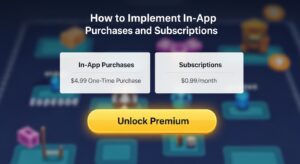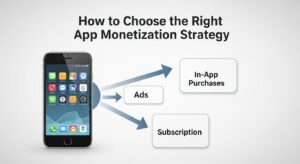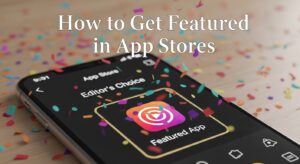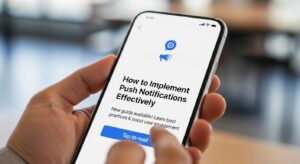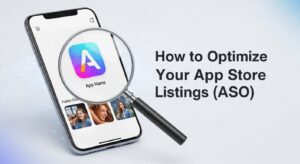When you’re ready to monetize and market your mobile app, you’re entering a competitive landscape where success requires both strategic thinking and tactical execution. The mobile app industry generated over $935 billion in revenue in 2023, yet many developers struggle to capture their share of this massive market.
Understanding how to effectively monetize and market your mobile app isn’t just about building great features—it’s about creating sustainable revenue streams while reaching the right users at the right time. Whether you’re launching your first app or looking to optimize an existing one, this comprehensive guide will walk you through proven strategies that successful app developers use to generate consistent profits.
Understanding Your App’s Monetization Potential
Before diving into specific strategies to monetize and market your mobile app, you need to assess your app’s unique value proposition. Different app categories have varying monetization potentials and user behavior patterns.
Gaming apps typically perform well with freemium models and in-app purchases, while productivity apps often succeed with subscription models. E-commerce apps naturally lend themselves to transaction-based revenue, and utility apps might work better with one-time purchases or premium versions.
Consider your target audience’s spending habits and preferences. Are they price-sensitive students or professionals with disposable income? Do they prefer one-time payments or ongoing subscriptions? These insights will guide your monetization strategy decisions.
Strategy 1: Master App Store Optimization (ASO)
App Store Optimization is fundamental when you want to monetize and market your mobile app effectively. ASO is essentially SEO for app stores, helping your app rank higher in search results and category listings.
- Keyword Research and Implementation: Start by researching relevant keywords using tools like App Annie or Sensor Tower. Focus on keywords with high search volume but moderate competition. Include your primary keywords in your app title, subtitle, and description naturally.
- Visual Assets Optimization: Your app icon, screenshots, and preview video are crucial conversion elements. Create compelling visuals that clearly communicate your app’s value proposition. A/B testing different creative assets can significantly improve your conversion rates.
- User Reviews and Ratings Management: Actively encourage satisfied users to leave positive reviews. Respond professionally to negative feedback and use it to improve your app. Higher ratings directly correlate with better app store rankings and increased downloads.
ASO Element | Impact on Downloads | Optimization Frequency |
App Title | High | Once per major update |
Keywords | High | Monthly review |
Screenshots | Medium-High | Quarterly testing |
Description | Medium | Bi-monthly updates |
Reviews/Ratings | High | Ongoing management |
Strategy 2: Choose the Right Monetization Model
Selecting the appropriate monetization model is crucial to successfully monetize and market your mobile app. Each model has distinct advantages and works better for specific app types and user behaviors.
- Freemium Model: The freemium approach offers basic functionality for free while charging for premium features. This model works exceptionally well for apps where users can experience significant value before upgrading. Examples include productivity tools, photo editing apps, and fitness trackers. To succeed with freemium, ensure your free version provides enough value to engage users while creating clear upgrade incentives. The key is finding the right balance between free features and premium offerings.
- Subscription Model: Subscription models generate recurring revenue and are ideal for apps that provide ongoing value. Content apps, productivity suites, and SaaS-style mobile applications perform well with subscriptions. Offer multiple subscription tiers and consider free trial periods to reduce friction for new subscribers. Recurly’s research shows that apps with free trials have 30% higher conversion rates than those without.
- In-App Purchases: In-app purchases work well for gaming apps, virtual goods, and consumable content. This model allows users to enhance their experience through additional features, content, or virtual items. Implement a thoughtful in-app purchase strategy that enhances rather than interrupts the user experience. Avoid creating “pay-to-win” scenarios that might frustrate users.
Strategy 3: Implement Strategic User Acquisition
To effectively monetize and market your mobile app, you need a multi-channel user acquisition strategy that balances cost with quality users.
Paid Advertising Campaigns
Platforms like Facebook Ads, Google Ads, and Apple Search Ads offer targeted advertising options for mobile apps. Start with small budgets to test different audiences, creatives, and bidding strategies.
Focus on return on ad spend (ROAS) rather than just cost per install (CPI). A user who costs $5 to acquire but generates $20 in lifetime value is more valuable than a $2 user who never makes a purchase.
Organic Growth Strategies
Content marketing, social media engagement, and influencer partnerships can drive organic app downloads. Create valuable content that addresses your target users’ pain points and naturally promotes your app’s benefits.
Consider partnering with micro-influencers in your app’s niche. They often have higher engagement rates and more affordable partnership costs than macro-influencers.
Strategy 4: Optimize User Onboarding and Retention
The most expensive part of mobile app monetization isn’t acquiring users—it’s losing them before they provide value. A well-designed onboarding process is essential to monetize and market your mobile app successfully.
Streamlined Onboarding Process
Design an onboarding flow that quickly demonstrates your app’s core value. Reduce friction by minimizing required steps and information requests. Use progressive disclosure to introduce features gradually rather than overwhelming new users.
Retention Optimization Techniques
Implement push notifications strategically to re-engage users without becoming annoying. Personalize the user experience based on behavior and preferences. Regular app updates with new features and improvements keep users engaged and interested.
Localytics research indicates that apps with personalized push notifications see 27% higher open rates than generic messages.
Strategy 5: Leverage Data Analytics for Growth
Data-driven decision making is crucial when you want to monetize and market your mobile app effectively. Understanding user behavior patterns helps optimize both monetization and marketing efforts.
Key Metrics to Track
Monitor essential metrics including daily active users (DAU), monthly active users (MAU), retention rates, lifetime value (LTV), and customer acquisition cost (CAC). These metrics provide insights into user engagement and monetization efficiency.
Track conversion funnels to identify where users drop off in your monetization process. Small improvements in conversion rates can significantly impact overall revenue.
A/B Testing Implementation
Continuously test different elements of your app including pricing, feature placement, onboarding flows, and promotional offers. Use tools like Firebase or Optimizely to run controlled experiments.
Test one element at a time to isolate the impact of specific changes. Document your findings and build a knowledge base of what works for your specific user base.
Strategy 6: Build Strategic Partnerships
Partnerships can significantly accelerate your efforts to monetize and market your mobile app. The right partnerships provide access to new users, additional revenue streams, and enhanced app functionality.
- Cross-Promotion Opportunities: Partner with complementary apps to cross-promote to each other’s user bases. For example, a fitness tracking app might partner with a nutrition app for mutual promotion. These partnerships often provide high-quality users at low acquisition costs.
- Integration Partnerships: Integrate with popular platforms and services your users already use. For instance, a productivity app might integrate with Google Drive, Dropbox, and Slack. These integrations add value for users while potentially opening new monetization channels.
Strategy 7: Implement Advanced Monetization Techniques
Once you’ve mastered the basics of how to monetize and market your mobile app, consider advanced techniques that can significantly boost revenue.
- Dynamic Pricing Strategies: Implement pricing strategies that adjust based on user behavior, market conditions, or seasonal factors. Geographic pricing can help capture value in different markets while remaining accessible to price-sensitive users.
- Loyalty Programs and Gamification: Reward loyal users with exclusive features, discounts, or virtual rewards. Gamification elements like achievements, leaderboards, and progression systems can increase engagement and spending.
- Revenue Diversification: Don’t rely on a single revenue stream. Successful apps often combine multiple monetization methods. For example, a freemium app might also include affiliate marketing, sponsored content, or premium support options.
Monetization Method | Revenue Predictability | Implementation Complexity | User Impact |
Subscriptions | High | Medium | Low-Medium |
In-App Purchases | Medium | Low-Medium | Medium |
Advertising | Low-Medium | Low | Medium-High |
Premium Version | Medium | Low | Low |
Measuring Success and Scaling
To truly succeed in your mission to monetize and market your mobile app, you need robust measurement systems and scaling strategies.
- Revenue Tracking and Analysis: Implement comprehensive revenue tracking that accounts for all monetization channels. Use analytics platforms like Mixpanel or Amplitude to understand revenue attribution and user journey insights. Monitor key performance indicators (KPIs) regularly and set up automated alerts for significant changes. This proactive approach helps you quickly identify and address issues or opportunities.
- Scaling Successful Strategies: Once you identify successful monetization and marketing strategies, systematically scale them. Increase budgets for profitable advertising channels, expand successful partnerships, and replicate winning features across your app portfolio. Consider international expansion when your domestic market reaches saturation. Localize your app for new markets, considering cultural preferences, payment methods, and regulatory requirements.
Common Pitfalls to Avoid
Learning how to monetize and market your mobile app includes understanding what not to do. Avoid these common mistakes that can derail your success:
Overmonetizing your app with excessive ads or paywalls can drive users away. Focus on providing value first, then monetizing appropriately. Don’t neglect user feedback—it provides valuable insights for improving both your product and monetization strategy.
Avoid feature creep that dilutes your app’s core value proposition. Stay focused on solving your users’ primary problems exceptionally well rather than trying to be everything to everyone.
Future-Proofing Your App Business
The mobile app landscape continuously evolves, so your strategies to monetize and market your mobile app must adapt accordingly. Stay informed about platform changes, new monetization options, and emerging technologies like augmented reality or artificial intelligence.
Consider subscription model trends, which are growing across all app categories. Privacy changes affecting advertising targeting require greater focus on first-party data collection and retention-based growth strategies.
Conclusion: Your Path to App Success
Successfully learning how to monetize and market your mobile app requires combining strategic thinking with tactical execution. Start with solid app store optimization and choose monetization models that align with your users’ preferences and behaviors.
Focus on acquiring quality users rather than just maximizing download numbers. Implement robust analytics to make data-driven decisions and continuously optimize your strategies based on real user behavior.
Sustainable app success comes from providing genuine value to your users while building efficient monetization systems. The strategies outlined in this guide provide a roadmap, but your specific execution should reflect your unique app, market, and user base.
By implementing these proven strategies systematically and remaining adaptable to market changes, you’ll be well-positioned to build a profitable mobile app business that stands the test of time.





